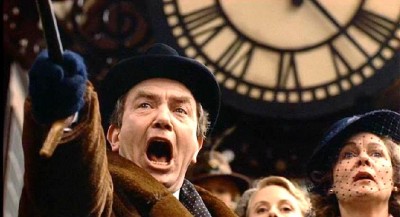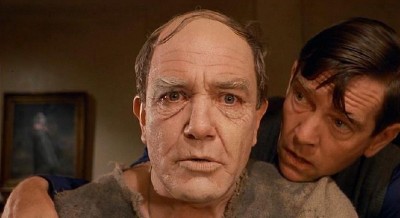
Whether you view him as the consummate professional craftsman or the ultimate hired gun director, one thing is certain—you can go up and down Peter Yates’ filmography and you’ll never make any real sense out of it. What do Bullitt (1968), For Pete’s Sake (1974), Mother, Jugs & Speed (1976), Krull (1983), and The Dresser (1983) have in common? Nothing, except that Yates made them. If you can detect any stylistic or thematic pattern to those films, please share your medication with me. Seriously, did anyone—apart from family and friends—ever go to see a Peter Yates movie because it was a Peter Yates movie? No, they went because of the stars or the genre or the fact that there was a movie in which Raquel Welch played a character named Jugs. And that brings us to The Dresser, which—despite its outbursts of comedy —is every inch a prestige picture. It’s a solid film version of Ronald Harwood’s play—intelligently, but not overly opened up for the movies—and since Harwood himself did the adaptation, one may assume he approved of it.

The film concerns an over-the-hill Shakespearean actor called Sir (Albert Finney)—presumably because of a knighthood and because Sir is a not-at-all-veiled depiction of Sir Donald Wolfit, for whom author Ronald Harwood once served as dresser, here called Norman (Tom Courtenay) and presented as a tippling and very fussy gay man. This, however, does not mean that The Dresser—though almost certainly loaded with nuggets of reality—is anything like a true story. Among other things, it doesn’t quite work out as history. Moreover, it’s a bit of an outrage on Wolfit, while at the same time a wayward love letter to the old actor—ending up as less history as it was and more history as it should have been. The film presents Sir as both a deluded, rapidly failing has-been, and as a truly majestic force of nature. The film’s early scene where Sir quite literally stops a train he’s late for by the sheer power of of his voice quickly establishes the latter. But it quickly transpires that such moments are increasingly infrequent.

Sir is in the midst of a tour—at the height of WWII—taking the Bard—and his interpretation of him—to the provinces. The problem is he doesn’t always seem to know where he is, possibly who he is, or what play he’s supposed to be performing. Sir is totally reliant on Norman to get him through—a daunting task when it includes such things as finding Sir making himself up in blackface for King Lear. Much of the film takes place in the dressing room—a great deal of it strictly between the two leads—but in some ways it’s the onstage material that’s the most interesting. It’s here that Sir—and by extension Sir Donald—gets his due. Sir may be failing. He may be an exponent of a style of acting that wouldn’t be served at a kosher table. But he still has the power to move and to hold an audience. This, I think, is what raises the film to something far beyond a mere backstage amusement.
The Hendersonville Film Society will show The Dresser Sunday, March 23, at 2 p.m. in the Smoky Mountain Theater at Lake Pointe Landing Retirement Community (behind Epic Cinemas), 333 Thompson St., Hendersonville.




Before you comment
The comments section is here to provide a platform for civil dialogue on the issues we face together as a local community. Xpress is committed to offering this platform for all voices, but when the tone of the discussion gets nasty or strays off topic, we believe many people choose not to participate. Xpress editors are determined to moderate comments to ensure a constructive interchange is maintained. All comments judged not to be in keeping with the spirit of civil discourse will be removed and repeat violators will be banned. See here for our terms of service. Thank you for being part of this effort to promote respectful discussion.